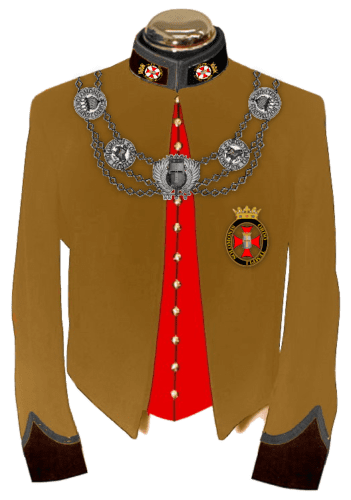This page features information about joining the Order of the Temple of Solomon, beginning as a Templar Sergeant (men) or Templar Adjutante (women), or as a Temple Guardian (special cases), in general membership. Serving as a Sergeant, Adjutante or Temple Guardian is the primary form of full membership in the Order, which is necessary to begin active participation for earning the official chivalric status of a Knight or Dame in nobility.

Vatican scholars documented that the Templar Order was comprised of “the knights, equipped like the heavy cavalry… [and] the Serjeants, who formed the light cavalry”, and more than half of all Templars were Sergeants. Accordingly, the majority of Templar membership was actually Sergeants, making that position authentically the primary category of general membership in the Order. [1]
The Temple Rule of 1129 AD described Sergeants as those “who wish to serve in charity in the Order of the Temple for the salvation of their souls”, and established that they are enrolled by giving their “commitments” (Rule 67). Sergeants were issued official Templar uniforms, but their tunics were black in color, to distinguish them from the Knights who wore light sand-colored tunics (Rule 68). [2]
The word Sergeant, from the 12th century Old French word ‘sergent’ or ‘serjant’, means a soldier who is an official of a court of nobility. By 1300 AD the duties of a Sergeant included enforcing judgments and orders of state, taking on the role of a sheriff. Later in the 14th century this became known as “Sergeant at Arms”. During the Renaissance period ca. 1545 AD, Sergeant was recognized as a special type of military “non-commissioned officer” or “warrant officer”, essentially a skilled soldier who served the Crown as an independent professional. [3]
Alternate Title for Women – Women are also authentically members of the Templar Order, as proven by the historical record, despite being excluded from other medieval chivalric Orders: The Temple Rule as its founding charter mentions a pre-existing “practice” of admitting women (Rule 70), and makes multiple references to women among Templars in active service (Rules 72, 541, 679) [4]. In 1305 AD the Templar Order acquired at least one female monastery, and the Abbess was admitted and took Templar Vows. [5]
For women, from the traditional French military system, the alternative title of non-commissioned officer or warrant officer which is equivalent to a Sergeant is “Adjutant”. The title comes from the Latin word ‘adjutare’ meaning to “assist” and “support”, based on the root word ‘iuvare’ meaning “to give strength” [6]. Grammatically, the feminine form of the word adds the letter “e” at the end, making the correct and authentic title for women “Adjutante” (pronounced like “debutante”).
Full Templar Membership – Historically, Sergeants and Adjutantes are full members of the Templar Order, in active service, participating in all Templar missions. Despite the apparent military style of those titles, they are technically not a “rank” of Chivalry, but rather constitute a distinct class of skilled professionals, directly assisting and supporting the Knights and Dames.
Although Sergeants and Adjutantes are equally Templar Brothers and Sisters of the Order, they have not yet received official status as a Knight or Dame. Sergeants and Adjutantes are in the prime position to become a titled Knight or Dame, through active participation and effective service in the Order, by demonstrating merit to earn knighthood or damehood in nobility.
In the modern Templar Order, men can use the title “Sergeant of the Temple of Solomon”, the post-nominal indication “STS”, or the short form “Templar Sergeant”; Women can use the title “Adjutante of the Temple of Solomon”, the post-nominal indication “ATS”, or the short form “Templar Adjutante”.
Alternate Title in Some Cases – In situations where it might not be appropriate to call the member a “Sergeant” or “Adjutante”, the alternative title of “Temple Guardian” can be used, such as for a person who: (1) intends to earn “Donat of Devotion” status instead of Knight or Dame elevation, (2) is already a nobiliary Knight or Dame of another historical Order but has not yet earned the same in the Templar Order, or (3) holds major Nobility status in a genuine recognized Royal House.
Temple Guardian status is an equivalent position in general membership, also as Templar Brothers and Sisters of the Order on a path towards earning Templar knighthood or damehood. Men and women can use the title “Guardian of the Temple of Solomon”, the post-nominal indication “GTS”, or the short form “Temple Guardian”.
 Under the Temple Rule of 1129 AD, Sergeants and Adjutantes were required only to give their “Commitment” (Rule 67), which historically was a contract for a fixed term of service [7]. In the modern Templar Order, this is effectively fulfilled by pledging one’s Commitment of Service, essentially agreeing to live by the principles of the Temple Rule of 1129 AD, which in turn embodies the Templar Code of 1150 AD.
Under the Temple Rule of 1129 AD, Sergeants and Adjutantes were required only to give their “Commitment” (Rule 67), which historically was a contract for a fixed term of service [7]. In the modern Templar Order, this is effectively fulfilled by pledging one’s Commitment of Service, essentially agreeing to live by the principles of the Temple Rule of 1129 AD, which in turn embodies the Templar Code of 1150 AD.
After completing studies of the Templar Skills Training program, giving the Commitment of Service constitutes the short-form Induction ceremony for the new Sergeant or Adjutante or Temple Guardian. The term of chivalric service is open-ended, such that the member can hold their titled status at this level for life, for as long as they desire to remain a Templar in the Order of the Temple of Solomon.
For public transparency, the verbal formula for pledging one’s Commitment of Service in the restored Templar Order, is officially established as the following:
“By all that is Holy, before God and the Angels, through the Holy Spirit, I [name] wholeheartedly pledge this Commitment of Service: To live by the Temple Rule and serve the needs of the Order; To follow and uphold the Templar way of life; And defend the Order and my Brothers and Sisters against all enemies, external and internal. So help me God. Non nobis Domine. Amen.” (Based on Temple Rule, Rule 274)
 Popularized ceremonial regalia widely used by self-styled “Templar” themed groups is not authentic to the 12th century Order of the Temple of Solomon, but rather was invented by a 15th century fraternity which is not a chivalric Order [8].
Popularized ceremonial regalia widely used by self-styled “Templar” themed groups is not authentic to the 12th century Order of the Temple of Solomon, but rather was invented by a 15th century fraternity which is not a chivalric Order [8].
The Temple Rule of 1129 AD evidences that the iconic “white robes” from the first 10 years of the Order (1118-1128 AD) were quickly phased out, replaced by a “burell” shade of light-brown sand or cream color (Rule 68) [9]. Templar every-day working clothes were generally brown in color, and placing the red Templar Cross on the tunics and cloaks, established later in 1146 AD, was soon abolished because “the red cross would also serve as a bulls-eye for the enemies’ arrows and lances” [10].
The Temple Rule allowed only “robes… without any show of pride” (Rule 18), condemned any “pride or arrogance” desiring a “better robe” (Rule 19), required “no excess of vice” in one’s dress (Rule 21), and specifically prohibited “to have excess of… robes of length” (Rule 22). [11]

Sergeants & Adjutantes Badge & Livery Collar
The Temple Rule required “everyone to have the same” uniform (Rule 18), modified only by the Sergeants wearing black tunics, to distinguish them from the Knights (Rule 68) [12]. By historical precedent of the 12th century Teutonic Order, women as Templar Sisters wear the same uniform jacket as their Templar Brothers [13]. Authentic to this tradition, all Templar uniforms are identical, modified only by the color of narrow embroidered trim on the collar and sleeves, and the relevant insignia. Sergeants and Adjutantes thus wear the same uniform as all Knights and Dames and Crown Officers, only indicated with black trim.
The modern Order of the Temple of Solomon has adopted the 14th century Rules of Chivalric Regalia as codified in 1672 AD [14] and established as the international standard system in 1921 AD [15], as other surviving 12th century chivalric Orders have done as precedent [16].
The Templar uniform jacket is both practical and highly versatile, suitable for formal, semi-formal or informal dress. It is conservative with monastic modesty, designed to look modestly regal at ceremonial events, yet reasonably blend in at business meetings among lounge suits, or even to complement safari wear for active field work. Instead of storing it in a closet only for rare events, modern Templars can fully enjoy their uniform for every-day use in diverse situations.
The Order also reestablished proper use of the medieval Livery Badge and Livery Collar, as official insignia reserved for Chivalry and Nobility [17] [18], which were authorized to wear “at all feasts and in all companies” with all dress codes [19]. Sergeants and Adjutantes are distinguished by a “dark steel” metal for the Livery Badge and Livery Collar, which matches well with their embroidered black trim on the uniform jacket. Temple Guardians are distinguished by a “light steel” metal for the Livery Badge and Livery Collar.
As a result, in situations where the uniform is not used, Templar Sergeants, Adjutantes and Guardians can rightfully use the relevant chivalric badges and collars with smart casual dress, business dress and evening wear, expressing their official Templarism in diverse situations.

Sergeant Regalia (Lounge & Formal)

Adjutante Regalia (Lounge & Formal)
Regalia Purchased Separately – Regalia must be purchased separately, after completing studies of the Templar Skills Training Program and being installed as an official Templar by Letters Patent. Regalia costs are not included in the donations made by new members of the Order.
Illustrations May Enlarge Sizes – For the purposes of Illustration, regalia accessories and insignia may appear larger than their actual size proportional to the clothing, for better visibility of detail. Actual sizes are strictly and precisely in accordance with the international standard rules as used by all governments and legitimate chivalric Orders.
Access the Membership Platform to Join the Templar Order.
Learn about Modern Templar Missions as membership activities.
Learn about receiving Donat Patron status without formalities.
Learn about elevation to Knight or Dame in nobility.
[1] Vatican, The Catholic Encyclopedia (1912), The Encyclopedia Press, New York (1913), Volume 14, “Templars, Knights”, p.493.
[2] Henri de Curzon, La Règle du Temple, La Société de L’Histoire de France, Paris (1886), in Librairie Renouard, Rules 67-68.
[3] Douglas Harper, Online Etymology Dictionary (2015), “Sergeant”.
[4] Henri de Curzon, La Règle du Temple, La Société de L’Histoire de France, Paris (1886), in Librairie Renouard, Rules 70, 72, 541, 679.
[5] Henri de Curzon, La Règle du Temple, (1886), p.69, Note 1 to Rule 70; De Wal, Recherches sur l’Ordre Teutonique (1807), Vol.1, p.262.
[6] Douglas Harper, Online Etymology Dictionary (2015), “Adjutant”, “Aid”.
[7] Henri de Curzon, La Règle du Temple, La Société de L’Histoire de France, Paris (1886), in Librairie Renouard, Rule 67.
[8] John Yarker, The Arcane Schools, Manchester (1909), pp.341-342.
[9] Henri de Curzon, La Règle du Temple, La Société de L’Histoire de France, Paris (1886), in Librairie Renouard, Rule 68.
[10] Frank Sanello, The Knights Templars: God’s Warriors, the Devil’s Bankers, Taylor Trade Publishing, Oxford (2003), pp.14-15.
[11] Henri de Curzon, La Règle du Temple, La Société de L’Histoire de France, Paris (1886), in Librairie Renouard, Rules 18-19, 21-22.
[12] Henri de Curzon, La Règle du Temple, La Société de L’Histoire de France, Paris (1886), in Librairie Renouard, Rules 18, 68.
[13] François Velde, Women Knights in the Middle Ages, Heraldica (1996), updated (2003),”Women in the Military Orders”.
[14] Elias Ashmole, Institution Laws and Ceremonies of the Most Noble Order of the Garter, Hammet Publishing, London (1672), with engravings by Wenceslaus Hollar (33 plates), digitized by Folger Shakespeare Library.
[15] Herbert Arthur Previté Trendell, Dress and Insignia Worn at His Majesty’s Court, Harrison & Sons, for Lord Chamberlain’s Office, London (1921).
[16] Noel Cox, The Robes and Insignia of the Most Venerable Order of the Hospital of St John of Jerusalem, Arma: Journal of the Heraldry Society of Southern Africa (1999-2000), Issue 5.2.
[17] Peter Brown, A Companion to Chaucer, Wiley-Blackwell (2002), p.17.
[18] Chris Given-Wilson, Richard II and the Higher Nobility, in Anthony Goodman & James Gillespie, Richard II: The Art of Kingship, Oxford University Press (2003), p.126.
[19] Susan Crane, The Performance of Self, University of Pennsylvania Press (2002), p.19.
[20] Henri de Curzon, La Règle du Temple, La Société de L’Histoire de France, Paris (1886), in Librairie Renouard, Rules 1, 6, 9.
[21] Henri de Curzon, La Règle du Temple, La Société de L’Histoire de France, Paris (1886), in Librairie Renouard, Rules 11, 14.
You cannot copy content of this page
